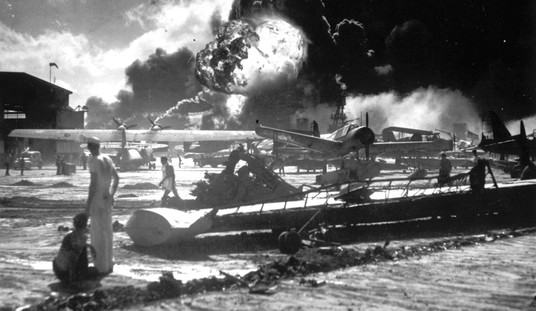On a tour of Sydney Harbour’s historical defenses the guide stopped at a muzzle loading cannon. He turned to the group he was guiding and said, “you will note that the gun carriage and the decks were painted red. Now why the color red? Is there any among you who knows the reason?”
Since nobody else volunteered a reply, I said “it is painted red to keep up morale; to prevent the blood from being too obvious when the deck ran with it.” The guide said, “give the man a cigar. The horrors of naval warfare in the Age of Sail were unimaginable.” He might have added that they were pretty bad in the Age of Steam as well. Seventy years ago a US Navy carrier task force met the finest naval aviation in the world off a tiny speck called Midway. Jonathan Parshall’s Shattered Sword is probably the best account of the Battle of Midway that I have read. He sets the scene for the doomed contest between the men of the Kaga and the fire that was about to engulf their mighty ship after it had been hit by four bombs.
WW II-era warships were marvelously flammable. Anyone who has been on board a ship of that vintage will have noticed that one of the prevalent odors present is that of petroleum distillates, in the form of lubricants, solvents, gasoline, and thousands of tons of fuel oil. Added to this, of course, was ammunition for the ship’s guns, which was stored primarily in the magazines, but smaller quantities of which were kept in ready storage lockers near the guns for quick access during an attack. In contrast to today’s warships, oil-based paints were used extensively. Wiring ways were filled with insulation that could ignite at high temperature, as could piping insulation (which in Japanese warships was often made of wood). Damage-control lockers themselves contained wood beams for shoring, and additional shoring material was usually stowed in the overheads of companionways and anywhere else sufficient space could be found …
Kaga‘s hangar was littered with an incredible array of munitions. Between the arming of the first and second strike waves and the inability to stow the land-attack weapons, Kunisada would later estimate that Kaga’s hangars probably contained twenty torpedoes (240-kilogram warhead), twenty-eight 800-kilogram bombs, and forty 250-kilogram bombs. This appalling total of nearly 80,000 pounds of explosives lay scattered everywhere, on aircraft, on bomb carts, or simply shoved against the hangar bulkheads to get them out of the way. The forward bomb hits both landed within spitting distance of the ordnance lift, which was abreast the midships aircraft elevator. The area around this lift was piled with 800-kilogram bombs waiting to be sent back below to the magazines. With the hangars fully enclosed, none of these weapons could now be jettisoned. The bombs were heavy enough, but the torpedoes were absolutely impossible to move. They weighed roughly 1,800 pounds apiece and were most likely affixed to an airplane to boot. With the elevators destroyed or inaccessible, there was no possibility of carrying them topside and heaving them overboard. And there was no way to move them out of harm’s way on the hangar deck, since there were fires burning literally everywhere.
Far worse, though, was the fact that the American attack had caught Kaga with her fueling system unsecured. Her fuel mains had almost certainly been ruptured in one or more places by the hits. Even if only the Type 97s and Zeros were fully gassed, there were still almost 10,000 gallons of fuel sloshing about in the aircraft, in addition to what was now pouring from the fuel lines.’ Freely flowing aviation fuel being dumped from many sources meant that the fuel was being distributed in large slicks all over the hangar deck. Not all of it was on fire yet. But in the presence of high ambient temperatures, aviation gasoline was now vaporizing at a prodigious rate. Though no one probably knew it, a catastrophic explosion on board Kaga could not be long in coming.
What happened on the Kaga occurred to varying degrees in every one of the carriers that was seriously struck during the Pacific War. The horrors of the Age of Steam were as bad if not worse than in navies where the decks ran red with blood. In the end nothing could be done to save the Kaga, though more than 800 Japanese sailors died trying. She literally melted — right down to the waterline in places. Here is Parshall’s description of how she looked when the decision was made to scuttle her.
It was clear that even if she could have been towed all the way back to Japan, Kaga would never sail again. Here, at the end of her terrible trial, everyone could see that she was fit for nothing more than the scrapyard. Her lower hull appeared to still be in good shape. But everything above was wrecked. Her midsection, from the bridge all the way aft to the rear elevator, had been utterly destroyed. Induced explosions had remorselessly demolished the hangars, chewing their way down all the way to the level of the lower main deck and the eight-inch casemate mounts. Where the hangars used to be, only a hellish pit of smoking, blackened metal remained. It was filled with charred structural members, melted and deformed aircraft pieces, and sundry equipment from the decks above-a hideous, tumbled graveyard lying over the hundreds of men who lay entombed in the engine rooms. The pit still smoked and spat. Yoshino could see all the way through the abyss to the sea beyond. It was as if the heart had been ripped out of the vessel. Only at the extreme rear, where the flight deck was supported by four massive pillars (and there had been nothing to burn) did a stump of intact decking remain. It stood there, suspended fifty feet above the ghastly charnel house of the hangars, almost in mockery of the countless sorties that had emanated from what had once been one of the largest flight decks in the Japanese Navy. The damage to the forward hangars was similar, although somewhat less severe. However, the port side of the forward hangars was blown asunder, doubtless because the ordnance lift had been located here. Flames, though much diminished now, still greedily licked at the openings. Kaga’s island was smashed, almost as if a giant’s hand had slapped the bridge, crushing it forward and down.’ The whole of it was charred and black, the paint having been consumed in the blaze, leaving only the scorched metal. inside, the bodies of Captain Okada and his senior officers still lay where they had fallen. In all, 811 of her crew now lay dead within the shattered wreck.
What must always be borne in mind is that if Spruance’s command been hesitant on June 4, or the fleet’s dive bombers less enterprising, or had luck been a little more to Japan’s side on that day the ghastly description above would have applied to the wrecks of the Hornet and Enterprise not to the Japanese carriers. The line which separated total victory from total defeat at Midway was exceedingly small.
In fact the interval during which what Parshall calls the “Iron Fist” decided the Pacific War was so brief — it lasted all of ten minutes, from 10:20 to 10:30 local — and its consequences so immense that it necessarily raises the question: how can power be so fragile? How could six months of Japanese runaway victory be undone is less than a quarter of an hour?
The answer lies in the nature of catastrophes. A catastrophe is an event which triggers the collapse of an entire system without a hope of recovery. It seems to create an effect all out proportion to its size. Now the key to the Japan’s power was its control of the sea. All else depended on that single point of dominance. What Spruance’s victory at Midway did was knock the linchpin out of the structure. Then, like a slow motion video of a building implosion the whole facade of Japanese power crumbled to the ground.
It was a cascading systems failure. “Cascading failures usually begin when one part of the system fails. When this happens, nearby nodes must then take up the slack for the failed component. This overloads these nodes, causing them to fail as well, prompting additional nodes to fail in a vicious cycle.” Midway knocked out just a single pin, but it was the only pin that mattered.
Since the 70th anniversary of Midway coincides with the modern Age of Too Big To Fail it is instructive to reflect on how catastrophes happen. If colossal structures like the EU resemble that vanished Japanese Fleet in that it depends upon a single point of failure, then they too can crumble faster than we think. Perhaps in the future some guide will lead a tour through one of those institutions and ask, “now why were there two sets of databases? Is there any among you who knows the reason?”
But in that future day no one can afford a cigar.
Belmont Commenters
How to Publish on Amazon’s Kindle for $2.99
The Three Conjectures at Amazon Kindle for $1.99
Storming the Castle at Amazon Kindle for $3.99
No Way In at Amazon Kindle $8.95, print $9.99










Join the conversation as a VIP Member